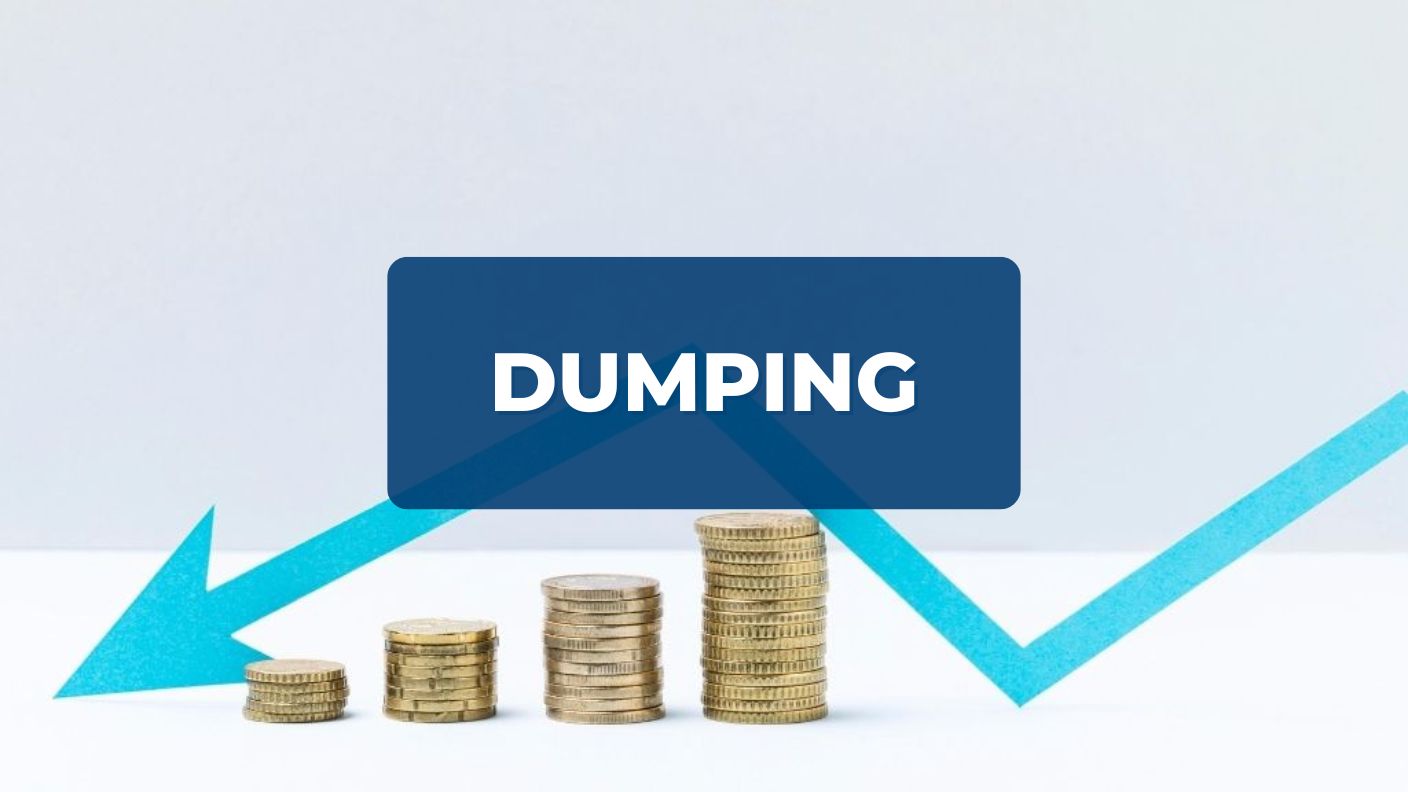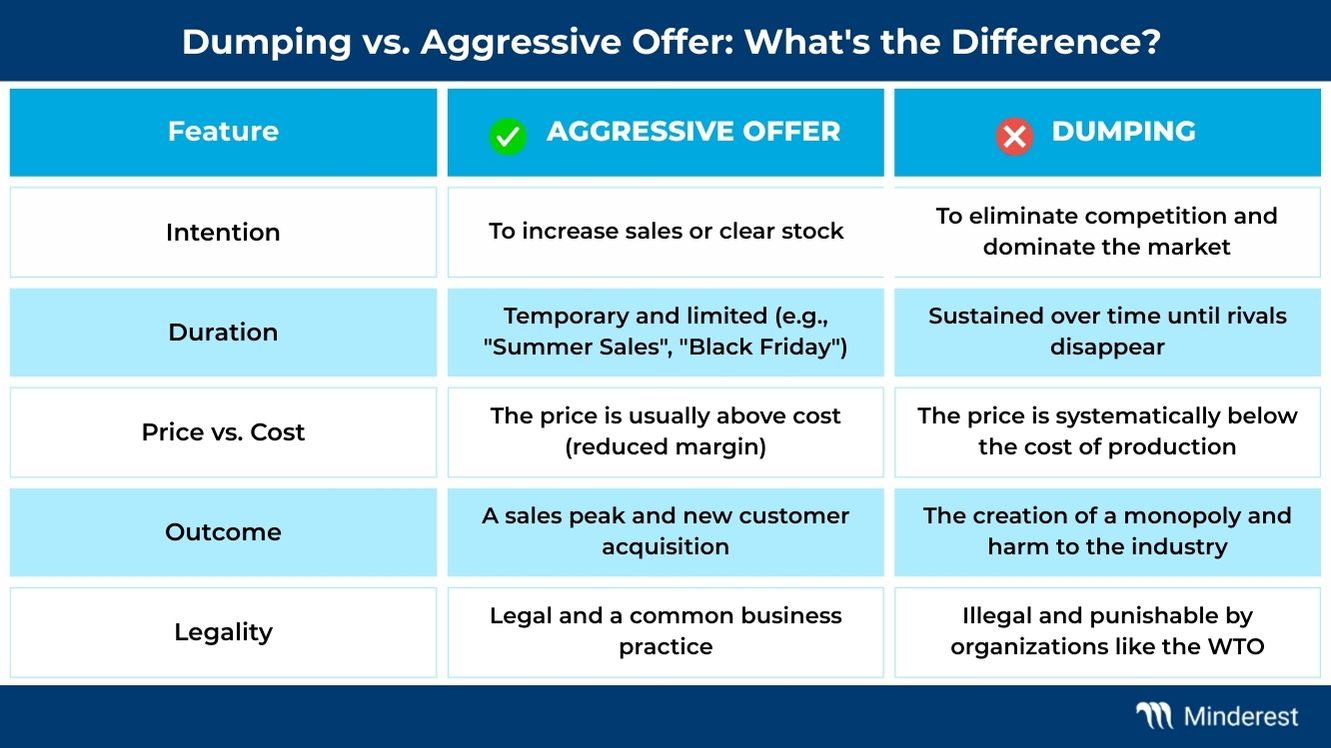
Dumping in eCommerce: What It Is, 7 Examples, and How to Protect Your Business
Dumping is an abusive practice of lowering prices to below-cost prices. Here are some examples.
Dumping is an abusive practice of lowering prices to below-cost prices. Here are some examples.

You’ve been there: you’re analyzing a competitor and find them selling a product at a price so low it seems impossible to make a profit. It could be a one-off sale, but if the practice continues over time, you might be dealing with a case of dumping. Far from being just an aggressive pricing strategy, dumping is an unfair competitive tactic designed to distort the market. Understanding how it works, its different forms, and, most importantly, how to protect your business is critical for the survival and growth of your eCommerce.
In eCommerce, price dumping is the practice of a company selling its products online at a price below its cost of production. The goal is to eliminate competition and dominate the market. This isn't a temporary promotion to clear out old stock; it's a sustained strategy aimed at driving other sellers out of business so that, once a monopoly or dominant position is achieved, prices can be raised without opposition.
This practice should concern you for several critical reasons:
To understand its real-world impact, let's look at how dumping manifests in the digital space with concrete examples.
Asian giants, thanks to ultra-optimized production and logistics models and, at times, strong financial backing, can offer products at prices that are unattainable for local sellers. This is an aggressive market penetration strategy designed to wipe out the competition.
A third-party seller on Amazon who needs cash fast might decide to sell their inventory below cost. Often, the goal is to secure quick sales to win the Amazon Buy Box, even though this aggressive tactic distorts marketplace pricing and affects all other competitors.
A country might subsidize the production of a certain food product. Its producers can then export it and sell it online in other countries at a price that local producers, without those subsidies, cannot compete against. A clear example was the complaint filed by Californian producers against Spanish black olives, whose prices were only possible due to EU subsidies.
Offering a free version of a software perpetually can be considered a form of strategic dumping. The goal is to create a massive barrier to entry for new competitors by capturing a large user base that may eventually convert to paying customers.
This involves brands that manufacture goods in countries with lax labor regulations, very low wages, and poor social protections. This allows them to drastically reduce their production costs and sell online at prices that companies manufacturing under ethical conditions cannot compete with.
An established brand in its home country decides to expand into a new market through its eCommerce store. To gain market share quickly, it sells its products online at a lower price than it offers in its own country, absorbing initial losses to eliminate local competition.
The U.S. and the European Union have imposed tariffs on numerous Chinese products, from solar panels to electric bikes, after proving they were being sold below their production cost thanks to state subsidies. This directly affects eCommerce businesses that base their model on importing these items.
Although the effect is similar, the intent and origin of dumping can vary. Recognizing the types will help you better understand the threat.
This is the most harmful form and is considered malpractice. Its sole intention is to drive competitors out of the market to establish a monopoly. The company is fully aware that it is taking short-term losses with the expectation of recouping them handsomely once it has full control over pricing. This is unfair eCommerce competition at its worst.
This occurs when artificially low prices are made possible by tax exemptions or direct government subsidies from the product's country of origin. The company isn't necessarily trying to be predatory, but the result for local competition is the same, creating a clear market distortion.
As seen in the fast fashion example, this happens when a company can sell at low prices because it benefits from negligible labor costs derived from permissive laws or labor exploitation in the manufacturing country. This artificially lowers its cost structure compared to socially responsible companies.

Dumping does not go unnoticed. Globally, the World Trade Organization (WTO) sets the rules that allow member countries to apply defensive measures, such as tariffs (import taxes), when it is proven that a trading partner is harming a domestic industry through this practice.
The authorities responsible for anti-dumping measures vary by jurisdiction: in the United States, the U.S. International Trade Commission (USITC) and the Department of Commerce investigate and impose duties; in the UK, the Trade Remedies Authority (TRA) investigates and makes recommendations to the government; while within the European Union, the European Commission is responsible for both investigating complaints and imposing measures.
Protecting your business from dumping is possible. Although filing a formal complaint is a complex process, as an eCommerce business, you can and should implement a data-driven defensive strategy.
Visibility is your first line of defense. You can't fight a threat you can't see. It's essential to use an automated tool like Minderest to track the prices of your key competitors and sellers on marketplaces daily and systematically. Without data, you only have suspicions.
With active monitoring, the next step is to analyze the data. Don't just look for one-off price drops; look for patterns. Has a competitor drastically lowered the price of a key product and maintained it for weeks? Is that price below a logical market threshold, considering product, logistics, and marketing costs? These are the real red flags.
Once you've identified a potentially predatory pricing pattern, it's time to act intelligently. Data allows you to move from reaction to strategy. This is where you must define your competitive pricing strategy: you might decide not to enter a direct price war but adjust other products in your catalog to remain competitive. Or you can reinforce your value proposition (shipping, customer service), or in extreme cases, document the practice for future action.
An integrated solution like Minderest not only automates the capture of this data but also provides you with the reports and alerts needed to execute these three steps efficiently, turning information into a strategic defense.
Is dumping illegal?
Yes, predatory dumping is considered an unfair trade practice and is punishable by national and international bodies like the WTO. However, proving it legally is a complex process that requires very solid evidence.
How can I report a dumping practice?
The formal process for reporting dumping is channeled through industry associations or directly to the national trade authority (like the USITC), by presenting a well-documented case. For an eCommerce business, the first step is always to collect accurate data.
What's the difference between dumping and an aggressive sale?
The main difference lies in intent and sustainability. A sale is temporary and seeks a spike in sales or to liquidate stock, generally respecting the cost threshold. Dumping, on the other hand, involves systematically selling below cost with the ultimate goal of eliminating competitors from the market.
Does dumping affect me if I do dropshipping?
Yes, significantly. If your supplier is accused of dumping, the products you sell could suddenly become subject to anti-dumping tariffs. This would destroy your profit margins overnight and jeopardize the viability of your business.
Dumping in eCommerce is a real threat that can undermine the profitability of your business. Reacting late and without data will only lead you into an unsustainable price war. The key to protecting yourself is not panic, but preparation.
Implementing constant price monitoring, analyzing market patterns, and acting with a data-driven strategy is the only way to defend your position and ensure your long-term growth.
Ready to turn pricing data into your best strategic defense? Request a demo of Minderest's Competitor Price Monitoring tool.
Find out how Minderest can take your business to the next level.
Contact our pricing experts to see the platform in action.


